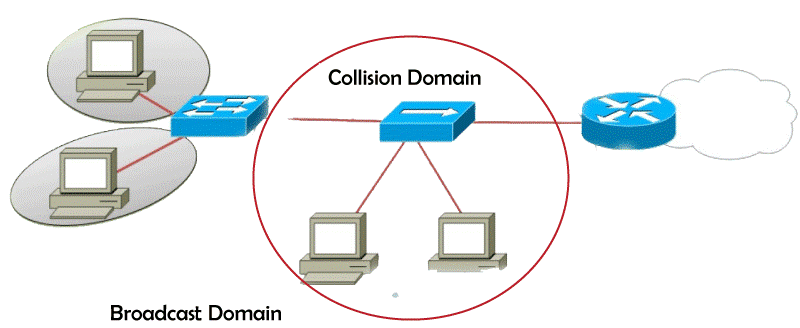Collision Domain and Broadcast Domain
Switches and routers are the most widely used network hardware. However, we frequently hear individuals referring to hubs, repeaters, and bridges. Have you ever wondered why the former devices are chosen instead of the latter devices? One explanation might be that they are stronger and more effective. But what is the real cause of their effectiveness? In this context, concepts like "Collision Domains" and "Broadcast Domains" are relevant.
Let's review that a hub is a multiple-port repeater before moving on. So that you may comprehend why repeaters and bridges aren't commonly used in production networks, consider how a switch functions as a multiple-port bridge (because of a smaller number of ports).
- Collision Domain
When a device transmits a message to the network, all other devices that are a part of its collision domain must pay attention to it, regardless of whether it was intended for them or not. This situation is known as a collision domain. This is problematic because it will result in a collision if two devices send out their messages at the same time, forcing them to wait and send them again one at a time. It only occurs using a half-duplex mode, so keep that in mind.
- Broadcast Domain
When a device transmits a broadcast message, all other devices in that device's broadcast domain must pay attention to it. This situation is known as a broadcast domain. As a result, the network experiences significant LAN congestion, which reduces the available bandwidth for the users.
This leads us to the conclusion that the network is more effective at supplying better bandwidth to all of its users. There should be more collision domains and more broadcast domains.
Which of our network devices are capable of violating collision domains, and which are capable of breaking broadcast domains? This question has to be answered now.
Let's now focus on Hubs, Switches, and Routers and talk about them in relation to the domains listed above.
- Hub - We begin with a hub because it needs to be eliminated as soon as feasible. Because it doesn't separate a collision domain from a broadcast domain, or in other words, a hub is neither a collision domain separator nor a broadcast domain separator. All of the hub-connected devices are contained within a single collision and broadcast domain. Keep in mind that hubs only connect network segments, not segment a network.
- Switches - Compared to the hub, we have an advantage with switches. A switch is a collision domain separator because each port on it is in a different collision domain. As a result, messages sent by devices connected to separate ports never collide. This aids in network design, but switches continue to be a challenge. It is not a broadcast domain separator because they never break broadcast domains. There is still only one broadcast domain for the entire switch's ports. Even if a device sends a broadcast message, congestion will still occur.
- Router - A router is a broadcast domain separator and a collision domain separator because it breaks both types of domains. A router can connect two networks. A broadcast message sent from one network to another will never be received because the router will never permit it to flow.

Furthermore, the only way repeaters and bridges differ from hubs and switches is in the number of ports. In contrast to a repeater, a bridge simply breaks collision domains; but a repeater does not break either collision or broadcast domain.
|

 For Videos Join Our Youtube Channel: Join Now
For Videos Join Our Youtube Channel: Join Now










